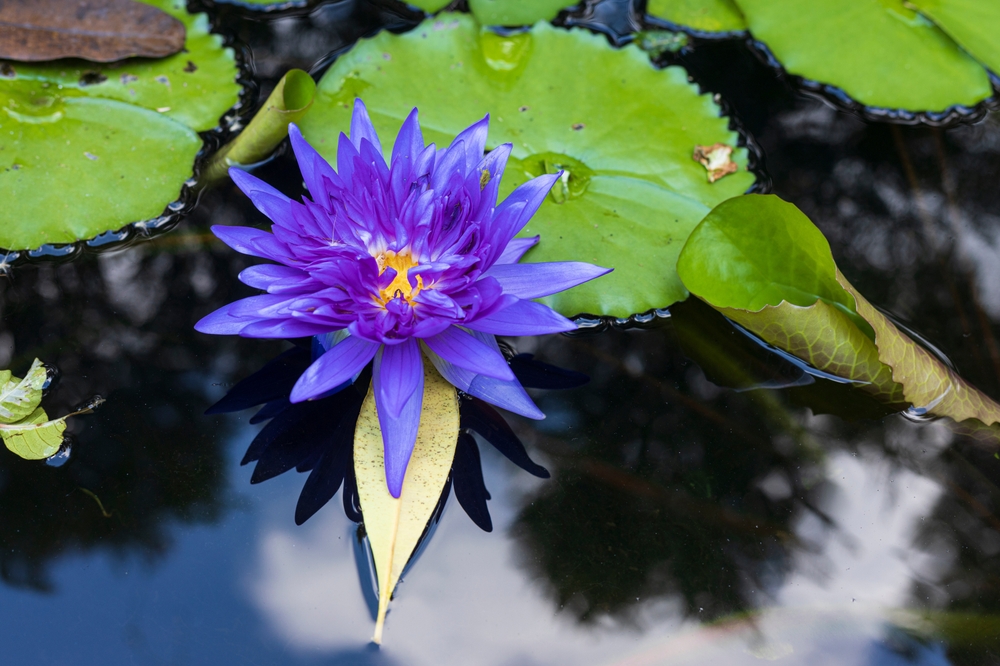Ever wondered what Cleopatra might have reached for when she had a headache? Or what remedies filled the medicine cabinets of pyramid builders? Turns out, one of ancient Egypt’s most treasured healing plants still exists today — and modern science is finally catching up to what the pharaohs knew thousands of years ago.
The plant that powered a civilization
In the scorching heat of the Nile Valley, where one of humanity’s greatest civilizations flourished, a humble blue flowering plant grew abundantly along riverbanks and in marshy areas. Known today as blue lotus, this aquatic beauty wasn’t just decorative — it was practically ancient Egypt’s pharmacy in a flower.
Depictions of the blue lotus appear everywhere in Egyptian art and artifacts. It adorns temple walls, jewelry, and ceremonial objects. The flower appears in countless paintings showing it being held, smelled, or worn by nobility and commoners alike. This wasn’t just artistic appreciation — these images documented a sophisticated understanding of plant medicine that predated modern pharmaceuticals by millennia.
Archaeological discoveries of preserved flowers in tombs and residue in ancient vessels confirm what historians long suspected — blue lotus wasn’t just symbolically important, it was actively used as medicine throughout Egyptian society for over 3,000 years.
The forgotten wisdom in ancient papyri
When archaeologists began translating medical papyri like the Ebers Papyrus from around 1550 BCE, they discovered detailed records of blue lotus preparations used to treat everything from pain and inflammation to anxiety and sleep disorders. The ancient Egyptians created tinctures, oils, and teas from different parts of the plant, each designed for specific health concerns.
What makes these ancient medical texts remarkable isn’t just their age but their sophistication. Egyptian physicians understood concepts like dosage, preparation methods, and even contraindications long before modern medicine formalized these practices. They documented specific extraction techniques to draw out different properties of the blue lotus depending on the condition being treated.
Even more fascinating? Their understanding of the plant’s effects aligns surprisingly well with what modern pharmacological research is now confirming about its compounds. Sometimes ancient wisdom isn’t so primitive after all.
The chemistry behind the magic
Modern scientists analyzing blue lotus have identified several bioactive compounds that explain why the ancient Egyptians valued it so highly. The plant contains aporphine, nuciferine, and various flavonoids that interact with the body’s nervous system in ways that produce mild sedative effects, reduce inflammation, and promote relaxation without heavy sedation.
These natural compounds work on some of the same neural pathways targeted by modern pharmaceuticals but in gentler, more balanced ways. Unlike many synthetic drugs that flood specific receptors with overwhelming force, plant medicines like blue lotus often contain multiple compounds that work together to create more nuanced effects with fewer side effects.
This might explain why ancient Egyptians used blue lotus for such a wide range of conditions. Its natural chemical profile doesn’t just address one symptom — it helps restore balance to multiple body systems simultaneously, an approach increasingly validated by contemporary research into whole-plant medicine.
The rediscovery changing modern wellness
After centuries of obscurity, blue lotus is experiencing a remarkable renaissance in holistic health circles. Herbalists, naturopathic doctors, and even some forward-thinking mainstream medical practitioners are reexamining this ancient remedy through the lens of modern science.
Early research suggests promising applications for anxiety, insomnia, and certain types of pain — exactly what the Egyptians used it for millennia ago. Some studies indicate potential neuroprotective properties that might help with conditions like Alzheimer’s and Parkinson’s, though more research is needed.
What makes this rediscovery particularly exciting is how it bridges ancient wisdom with contemporary wellness needs. As more people seek alternatives to pharmaceuticals with harsh side effects, traditional plant medicines backed by both historical use and emerging science offer compelling options.
The blue lotus exemplifies a growing recognition that traditional healing systems often contained profound insights that were forgotten or dismissed during the rise of synthetic pharmaceuticals — insights we’re now rediscovering with newfound appreciation.
Beyond physical healing
For the ancient Egyptians, blue lotus wasn’t just medicine for the body — it was medicine for the soul. The plant held profound spiritual significance, associated with rebirth, transcendence, and connection to higher consciousness. Hieroglyphics and art depict the lotus emerging from murky waters to bloom in the sunlight, symbolizing spiritual awakening and the triumph of light over darkness.
This spiritual dimension wasn’t separate from its healing properties but integral to them. Egyptian healing philosophy understood the connection between mental, emotional, and physical wellbeing thousands of years before modern medicine began acknowledging these relationships.
Modern users often report similar experiences — beyond physical relaxation, many describe enhanced dream states, improved meditation, and a sense of mental clarity when using blue lotus preparations. These subjective experiences align remarkably well with how ancient texts described the plant’s effects on consciousness and wellbeing.
This holistic understanding represents another layer of ancient Egyptian wisdom that transcends time — the recognition that true healing addresses the whole person, not just isolated symptoms.
Finding authentic connections to ancient wisdom
If you’re intrigued by blue lotus, approaching it with respect for its traditional uses offers the most authentic experience. Modern concentrated extracts often bear little resemblance to the preparations ancient Egyptians would have used.
Traditional methods like gentle water infusions, wine infusions, or oil preparations extract the plant’s properties in balanced ways that align more closely with historical usage. These gentler preparations also tend to preserve the subtle complexity of the plant’s effects rather than isolating or concentrating specific compounds.
It’s worth noting that while blue lotus is legal in most countries, regulatory status varies depending on preparation method and concentration. Consulting herbalists who understand both traditional usage and modern concerns ensures responsible exploration of this ancient remedy.
The bridge between worlds
Perhaps what’s most remarkable about blue lotus isn’t just its historical significance or medicinal properties, but how it serves as a living connection between ancient wisdom and modern wellness. When we prepare a blue lotus tea today, we’re participating in a healing tradition that has remained unbroken for thousands of years.
This continuity offers something precious in our fast-paced, disconnected world — a tangible link to ancestral knowledge and practices that have withstood the test of time. There’s something profoundly grounding about using a remedy that Egyptians might have recognized thousands of years ago.
As modern medicine continues rediscovering the value of traditional healing systems, plants like blue lotus remind us that sometimes the most innovative solutions are actually the most ancient ones. The wisdom of the pharaohs, preserved in papyrus and stone, might just hold answers to some of our most pressing modern health challenges.
















